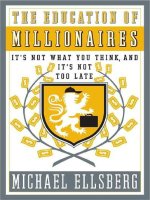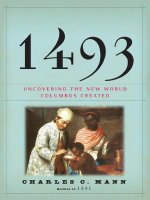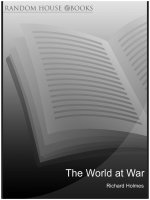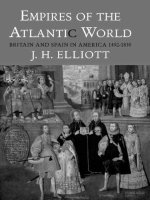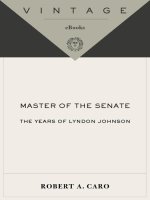Brenda wineapple white heat the friendship of son (v5 0)
Bạn đang xem bản rút gọn của tài liệu. Xem và tải ngay bản đầy đủ của tài liệu tại đây (2.71 MB, 360 trang )
Contents
Title Page
Dedication
List of Illustrations
Introduction: The Letter
One: The Letter
Part One: Before
Two: Thomas Wentworth Higginson: Without a Little Crack Somewhere
Three: Emily Dickinson: If I Live, I Will Go to Amherst
Four: Emily Dickinson: Write! Comrade, Write!
Five: Thomas Wentworth Higginson: Liberty Is Aggressive
Part Two: During
Six: Nature Is a Haunted House
Seven: Intensely Human
Eight: Agony Is Frugal
Nine: No Other Way
Ten: Her Deathless Syllable
Eleven: The Realm of You
Twelve: Moments of Preface
Thirteen: Things That Never Can Come Back
Fourteen: Monarch of Dreams
Fifteen: Pugilist and Poet
Sixteen: Rendezvous of Light
Part Three: Beyond the Dip of Bell
Seventeen: Poetry of the Portfolio
Eighteen: Me—Come! My Dazzled Face
Nineteen: Because I Could Not Stop
Acknowledgments
Notes
Selected Bibliography
Emily Dickinson Poems Known to Have Been Sent to Thomas Wentworth Higginson
Emily Dickinson Poems Cited
Also by Brenda Wineapple
Copyright
In memory of Sybille Bedford
Illustrations
Edward Dickinson, year 1853. (MS Am 1118.99b [17]. By permission of the Houghton Library,
Harvard University)
Emily Norcross Dickinson. (2007.1.1.2.L1.2.14NEG, Courtesy of the Monson Free Library Archives
Association)
North Pleasant Street home, Amherst, Massachusetts, 1840–1855. (MS Am 1118.99b [89]. By
permission of the Houghton Library, Harvard University)
William Austin Dickinson, 27 years old, 1856. (MS Am 1118.99b [14]. By permission of the
Houghton Library, Harvard University)
Lavinia Dickinson at 19, in 1852. (MS Am 1118.99b [28]. By permission of the Houghton Library,
Harvard University)
Emily Dickinson, daguerreotype, 17 years old, 1847. (Amherst College Archives and Special
Collections by permission of the Trustees of Amherst College)
Dickinson family silhouette, 1848. (MS Am 1118.4. By permission of the Houghton Library, Harvard
University)
Susan Gilbert. (Courtesy Todd-Bingham Picture Collection, Manuscripts & Archives, Yale
University Library)
Dickinson Homestead, 1858. (Courtesy Todd-Bingham Picture Collection, Manuscripts & Archives,
Yale University Library)
Samuel Bowles. (MS Am 111899b [6]. By permission of the Houghton Library, Harvard University)
Anthony Burns, 1855, broadside. (Boston: R. M. Edwards, 1855. Courtesy of the Library of
Congress, Department of Prints and Photographs)
Thomas Wentworth Higginson, 1857. (Courtesy of the Rare Book Department, Boston Public Library)
The Evergreens. (By permission of the Jones Library, Inc.; Amherst, Massachusetts)
African Americans, Beaufort, South Carolina, from the collection of Rufus Saxton. (Courtesy Rufus
and S. Willard Saxton Papers, Manuscripts & Archives, Yale University Library)
Smith Plantation, Beaufort, South Carolina, 1862. (Courtesy New-York Historical Society, War of
the Rebellion. Edisto Album PR-002-347.20)
Colonel Thomas Wentworth Higginson, First South Carolina Volunteers, 38 years old, 1862.
(Courtesy of the Clifton Waller Barrett Library of American Literature, Prints and Photographs,
University of Virginia)
Robert Gould Shaw, 1863. (Boston: John Adams Whipple, 1863. Courtesy of the Boston Athenaeum)
Thomas Wentworth Higginson at 46, in Rhode Island, 1870. (Courtesy Special Collections, Tutt
Library, Colorado College, Colorado Springs, Colorado)
Helen Hunt Jackson, 1875. (Courtesy Special Collections, Tutt Library, Colorado College, Colorado
Springs, Colorado)
Thomas Wentworth Higginson, in photograph sent to Emily Dickinson, 1876. (MS Am 1118.99b [45].
By permission of the Houghton Library, Harvard University)
Judge Otis Lord. (MS Am 1118.99b [55]. By permission of the Houghton Library, Harvard
University)
Higginson home, Buckingham Street, Cambridge, Massachusetts. (Courtesy of the Library of
Congress, Department of Prints and Photographs)
Edward (Ned) Dickinson, 20 years old, 1881. (MS Am 1118.99b [19]. By permission of the
Houghton Library, Harvard University)
Martha (Mattie) Dickinson. (MS Am 1118.99b [2]. By permission of the Houghton Library, Harvard
University)
David Todd and Mabel Loomis, engagement photograph, 1877. (Courtesy Todd-Bingham Picture
Collection, Manuscripts & Archives, Yale University Library)
Gilbert (Gib) Dickinson, age 4. (MS Am 1118.99b [25]. By permission of the Houghton Library,
Harvard University)
Higginson and daughter Margaret on tricycle, Cambridge, 1885. (Courtesy Todd-Bingham Picture
Collection, Manuscripts & Archives, Yale University Library)
Emily Dickinson, in photograph marked “Emily Dickinson,” from daguerreotype taken ca. 1853.
(Courtesy the Collection of Philip and Leslie Gura)
Mabel Loomis Todd in 1885, at 29. (Courtesy Todd-Bingham Picture Collection, Manuscripts &
Archives, Yale University Library)
Austin Dickinson, 61 years old, 1890. (Courtesy Todd-Bingham Picture Collection, Manuscripts &
Archives, Yale University Library)
Lavinia Dickinson, 1880s. (Courtesy Todd-Bingham Picture Collection, Manuscripts & Archives,
Yale University Library)
Thomas Wentworth Higginson at 80, in 1903. (Courtesy of the Rare Book Department, Boston Public
Library)
Introduction
The Letter
ONE
The Letter
This is my letter to the World
That never wrote to Me—
The simple News that Nature told—
With tender Majesty
Her Message is committed
To Hands I cannot see—
For love of Her—Sweet—countrymen—
Judge tenderly—of Me
Reprinted by Thomas Wentworth Higginson and Mabel
Loomis Todd in Emily Dickinson, Poems (1890)
Are you too deeply occupied to say if my Verse is alive?”
Thomas Wentworth Higginson opened the cream-colored envelope as he walked home from the
post office, where he had stopped on the mild spring morning of April 17 after watching young
women lift dumbbells at the local gymnasium. The year was 1862, a war was raging, and Higginson,
at thirty-eight, was the local authority on physical fitness. This was one of his causes, as were
women’s health and education. His passion, though, was for abolition. But dubious about President
Lincoln’s intentions—fighting to save the Union was not the same as fighting to abolish slavery—he
had not yet put on a blue uniform. Perhaps he should.
Yet he was also a literary man (great consolation for inaction) and frequently published in the
cultural magazine of the moment, The Atlantic Monthly, where, along with gymnastics, women’s
rights, and slavery, his subjects were flowers and birds and the changing seasons.
Out fell a letter, scrawled in a looping, difficult hand, as well as four poems and another, smaller
envelope. With difficulty he deciphered the scribble. “Are you too deeply occupied to say if my
Verse is alive?”
This is the beginning of a most extraordinary correspondence, which lasts almost a quarter of a
century, until Emily Dickinson’s death in 1886, and during which time the poet sent Higginson almost
one hundred poems, many of her best, their metrical forms jagged, their punctuation unpredictable,
their images honed to a fine point, their meaning elliptical, heart-gripping, electric. The poems hit
their mark. Poetry torn up by the roots, he later said, that took his breath away.
Today it may seem strange she would entrust them to the man now conventionally regarded as a
hidebound reformer with a tin ear. But Dickinson had not picked Higginson at random. Suspecting he
would be receptive, she also recognized a sensibility she could trust—that of a brave iconoclast
conversant with botany, butterflies, and books and willing to risk everything for what he believed.
At first she knew him only by reputation. His name, opinions, and sheer moxie were the stuff of
headlines for years, for as a voluble man of causes, he was on record as loathing capital punishment,
child labor, and the unfair laws depriving women of civil rights. An ordained minister, he had
officiated at Lucy Stone’s wedding, and after reading from a statement prepared by the bride and
groom, he distributed it to fellow clergymen as a manual of marital parity.
Above all, he detested slavery. One of the most steadfast and famous abolitionists in New England,
he was far more radical than William Lloyd Garrison, if, that is, radicalism is measured by a
willingness to entertain violence for the social good. Inequality offended him personally; so did
passive resistance. Braced by the righteousness of his cause—the unequivocal emancipation of the
slaves—this Massachusetts gentleman of the white and learned class had earned a reputation among
his own as a lunatic. In 1854 he had battered down a courthouse door in Boston in an attempt to free
the fugitive slave Anthony Burns. In 1856 he helped arm antislavery settlers in Kansas and, a loaded
pistol in his belt, admitted almost sheepishly, “I enjoy danger.” Afterward he preached sedition while
furnishing money and morale to John Brown.
All this had occurred by the time Dickinson asked him if he was too busy to read her poems, as if it
were the most reasonable request in the world.
“The Mind is so near itself—it cannot see, distinctly—and I have none to ask—” she politely lied.
Her brother, Austin, and his wife, Susan, lived right next door, and with Sue she regularly shared
much of her verse. “Could I make you and Austin—proud—sometime—a great way off—’twould
give me taller feet—,” she confided. Yet Dickinson now sought an adviser unconnected to family.
“Should you think it breathed—and had you the leisure to tell me,” she told Higginson, “I should feel
quick gratitude—.”
Should you think my poetry breathed; quick gratitude: if only he could write like this.
Dickinson had opened her request bluntly. “Mr. Higginson,” she scribbled at the top of the page.
There was no other salutation. Nor did she provide a closing. Almost thirty years later Higginson still
recalled that “the most curious thing about the letter was the total absence of a signature.” And he
well remembered that smaller sealed envelope, in which she had penciled her name on a card. “I
enclose my name—asking you, if you please—Sir—to tell me what is true?” That envelope, discrete
and alluring, was a strategy, a plea, a gambit.
Higginson glanced over one of the four poems. “I’ll tell you how the Sun rose—/ A Ribbon at a
time—.” Who writes like this? And another: “The nearest Dream recedes—unrealized—.” The thrill
of discovery still warm three decades later, he recollected that “the impression of a wholly new and
original poetic genius was as distinct on my mind at the first reading of these four poems as it is now,
after thirty years of further knowledge; and with it came the problem never yet solved, what place
ought to be assigned in literature to what is so remarkable, yet so elusive of criticism.” This was not
the benign public verse of, say, John Greenleaf Whittier. It did not share the metrical perfection of a
Longfellow or the tiresome “priapism” (Emerson’s word, which Higginson liked to repeat) of Walt
Whitman. It was unique, uncategorizable, itself.
The Springfield Republican, a staple in the Dickinson family, regularly praised Higginson for his
Atlantic essays. “I read your Chapters in the Atlantic—” Dickinson would tell him. Perhaps at
Dickinson’s behest, her sister-in-law had requested his daguerreotype from the Republican’s editor,
a family friend. As yet unbearded, his dark, thin hair falling to his ears, Higginson was nice looking;
he dressed conventionally, and he had grit.
Dickinson mailed her letter to Worcester, Massachusetts, where he lived and whose environs he
had lovingly described: its lily ponds edged in emerald and the shadows of trees falling blue on a
winter afternoon. She paid attention.
He read another of the indelible poems she had enclosed.
Safe in their Alabaster Chambers—
Untouched by Morning—
And untouched by noon—
Sleep the meek members of the Resurrection,
Rafter of Satin and Roof of Stone—
Grand go the Years,
In the Crescent above them—
Worlds scoop their Arcs—
And Firmaments—row—
Diadems—drop—
And Doges—surrender—
Soundless as Dots,
On a Disc of Snow.
White alabaster chambers melt into snow, vanishing without sound: it’s an unnerving image in a
poem skeptical about the resurrection it proposes. The rhymes drift and tilt; its meter echoes that of
Protestant hymns but derails. Dashes everywhere; caesuras where you least expect them, undeniable
melodic control, polysyllabics eerily shifting to monosyllabics. Poor Higginson. Yet he knew he was
holding something amazing, dropped from the sky, and he answered her in a way that pleased her.
That he had received poems from an unknown woman did not entirely surprise him. He’d been
getting a passel of mail ever since his article “Letter to a Young Contributor” had run earlier in the
month. An advice column to readers who wanted to become Atlantic contributors, the essay offered
some sensible tips for submitting work—use black ink, good pens, white paper—along with some
patently didactic advice about writing. Work hard. Practice makes perfect. Press language to the
uttermost. “There may be years of crowded passion in a word, and half a life in a sentence,” he
explained. “A single word may be a window from which one may perceive all the kingdoms of the
earth…. Charge your style with life.” That is just what he himself was trying to do.
The fuzzy instructions set off a huge reaction. “I foresee that ‘Young Contributors’ will send me
worse things than ever now,” Higginson boasted to his editor, James T. Fields, whom he wanted to
impress. “Two such specimens of verse came yesterday & day before—fortunately not to be
forwarded for publication!” But writing to his mother, whom he also wanted to impress, Higginson
sounded more sympathetic and humble. “Since that Letter to a Young Contributor I have more
wonderful expressions than ever sent me to read with request for advice, which is hard to give.”
Higginson answered Dickinson right away, asking everything he could think of: the name of her
favorite authors, whether she had attended school, if she read Whitman, whether she published, and
would she? (Dickinson had not told him that “Safe in their Alabaster Chambers” had appeared in The
Republican just six weeks earlier.) Unable to stop himself, he made a few editorial suggestions. “I
tried a little,—a very little—to lead her in the direction of rules and traditions,” he later reminisced.
She called this practice “surgery.”
“It was not so painful as I supposed,” she wrote on April 25, seeming to welcome his comments.
“While my thought is undressed—I can make the distinction, but when I put them in the Gown—they
look alike, and numb.” As to his questions, she answered that she had begun writing poetry only very
recently. That was untrue. In fact, she dodged several of his queries, Higginson recalled, “with a
naive skill such as the most experienced and worldly coquette might envy.” She told him she admired
Keats, Ruskin, Sir Thomas Browne, and the Brownings, all names Higginson had mentioned in his
various essays. Also, the book of Revelation. Yes, she had gone to school “but in your manner of the
phrase—had no education.” Like him, she responded intensely to nature. Her companions were the
nearby Pelham Hills, the sunset, her big dog, Carlo: “they are better than Beings—because they know
—but do not tell.”
What strangeness: a woman of secrets who wanted her secrets kept but wanted you to know she
had them. “In a Life that stopped guessing,” she once told her sister-in-law, “you and I should not feel
at home.”
Her mother, she confided, “does not care for thought,” and although her father has bought her many
books, he “begs me not to read them—because he fears they joggle the Mind.” She was alone, in other
words, and apart. Her family was religious, she continued, “—except me—and address an Eclipse,
every morning—whom they call their ‘Father.’” She would require a guidance more perspicacious,
more concrete.
As for her poetry, “I sing, as the Boy does by the Burying Ground—because I am afraid.” Such a
bald statement would be hard to ignore. “When far afterward—a sudden light on Orchards, or a new
fashion in the wind troubled my attention—I felt a palsy, here—the Verses just relieve—.”
In passing, she dropped an allusion to the two literary editors—she was no novice after all—who
“came to my Father’s House, this winter—and asked me for my Mind—and when I asked them
‘Why,’ they said I was penurious—and they, would use it for the World—.” It was not worldly
approval that she sought; she demanded something different. “I could not weigh myself—Myself,” she
promptly added, turning slyly to Higginson. This time she signed her letter as “your friend, E—
Dickinson.”
Bewildered and flattered, he could not help considering that next to such finesse, his tepid tips to a
Young Contributor were superfluous. What was an essay, anyway; what, a letter? Her phrases were
poems, riddles, lyric apothegms, fleeing with the speed of thought. Her imagination boiled over,
spilling onto the page. His did not, no matter how much heat he applied, unless, that is, he lost
himself, as he occasionally did in his essays on nature—some are quite magical—or in his writing on
behalf of the poor and disenfranchised, when he tackled his subject in clear-eyed prose and did not
let it go. Logic and empathy were special gifts. Yet by dispensing pellets of wisdom about how to
publish, as he did, in the most prestigious literary journal of the day, he presented himself as a
professional man of letters, worth taking seriously, which is just what he hoped to become.
This skilled adviser was not as confident as he tried to appear. Perhaps Dickinson sensed this. In
the aftermath of Harpers Ferry, Higginson had more or less packed away his revolver and retired to
the lakes around his home, where he scoured the woods after the manner of his favorite author, Henry
Thoreau. “I cannot think of a bliss as great as to follow the instinct which leads me thither & to wh. I
never yet dared fully to trust myself,” Higginson confided to his journals. He wrote all the time—
about slave uprisings and Denmark Vesey and Nat Turner and also about boating, snowstorms,
woodbines, and exercise. Fields printed whatever Higginson gave him and suggested he gather his
nature essays into a book.
But the Confederates had fired on Fort Sumter, and all bets were off. Then thirty-seven years old
(Dickinson was thirty), he unsuccessfully tried to organize a military expedition headed by a son of
John Brown’s, assuming that the mere sound of Brown’s name would wreak havoc in the South. He
tried to raise a volunteer regiment in Worcester. That, too, failed. “I have thoroughly made up my
mind that my present duty lies at home,” he rationalized.
By his “present duty” he meant his wife, an invalid who in recent years could not so much as clutch
a pen in her gnarled fingers. She needed him. “This war, for which I long and for which I have been
training for years, is just as absolutely unobtainable for me as a share in the wars of Napoleon,” he
confided to his diary. To console himself, he wrote the “Letter to a Young Contributor” in which he
declared one need not choose between “a column of newspaper or a column of attack, Wordsworth’s
‘Lines on Immortality’ or Wellington’s Lines of Torres Vedras; each is noble, if nobly done, though
posterity seems to remember literature the longest.” No doubt Dickinson agreed. “The General Rose
—decay—/ ,” she would write, “But this—in Lady’s Drawer / Make Summer—When the Lady lie /
In Ceaseless Rosemary—.”
South Winds jostle them—
Bumblebees come
Hover—Hesitate—Drink—and are gone—
Butterflies pause—on their passage Cashmere—
I, softly plucking,
Present them—Here—
Hover. Hesitate. Drink. Gone: the elusive Dickinson enclosed three more poems in her second
letter to Higginson, along with a few pressed flowers. He must have acknowledged the gift quickly,
for in early June she wrote him again. “Your letter gave no Drunkenness,” she replied, “because I
tasted Rum before—Domingo comes but once—yet I have had few pleasures so deep as your
opinion.”
That initial taste of rum had come from an earlier “tutor,” who had said he would like to live long
enough to see her a poet but then died young. As for Higginson’s opinion of her poetry, she took it
under ironic advisement. “You think my gait ‘spasmodic’—I am in danger—Sir—,” she wrote in June
as if with a grin. “You think me ‘uncontrolled’—I have no Tribunal.” To be sure, Higginson could not
have been expected to understand all she meant; who could? No matter. She did not enlist him for
that, or at least not for that alone. She wanted understanding and friendship, both of which he offered,
all-important to her even if his advice proved superfluous. “The ‘hand you stretch me in the Dark,’”
she said, “I put mine in.”
Nor would she admit to being put off by his apparent suggestion that she “delay” publishing. She
smiled archly. “‘To publish’—,” she shot back, “that being foreign to my thought, as Firmament to Fin
—.” Yet “if fame belonged to me,” she also observed, “I could not escape her—.” Perhaps he had
mentioned The Atlantic Monthly, where he often recommended new talent—particularly women—to
Fields. He need only dispatch one of her poems.
He did not.
That he told her to be patient seems paradoxical. This was the man who urged immediate, even
violent action in the political sphere. Yet he did not say she should never print her poems. He had
said “delay.” He needed to find his bearings. Her poetry shocked him, violating as it did the
canonical forms of meter and rhyme, and it stunned him with well-shaped insights that thrust him into
the very process of writing itself—the difficult transition from idea to page, the repeated attempts to
get it right:
We play at Paste—
Till qualified, for Pearl—
Then, drop the Paste—
And deem ourself a fool—
The Shapes—though—were similar—
And our new Hands
Learned Gem-tactics—
Practising Sands—
Having reminisced about her former tutor, Dickinson concluded her third letter with the suggestion
that Higginson replace him. “Would you have time to be the ‘friend’ you should think I need?” she
wondered with shy charm. “I have a little shape—it would not crowd your Desk—.” And though she
did not enclose any poems in this letter, she concluded with a verse:
As if I asked a common Alms,
And in my wondering hand
A Stranger pressed a Kingdom,
And I, bewildered, stand—
As if I asked the Orient
Had it for me a Morn—
And it should lift it’s purple Dikes,
And shatter Me with Dawn!
“But, will you be my Preceptor, Mr. Higginson?”
He could not say no.
Higginson had planned to write a sermon, “the Dreamer & worker—the day &
night of the soul.” “The Dreamer shld be worker, & the worker a dreamer,” he jotted in his notebook.
In a country that measures success in terms of profit rather than poetry, dreamers are an idle lot,
inconsequential and neglected. But inside every worker there’s a dreamer, Higginson hopefully
insisted, and by the same token dreamers can turn their fantasies to Yankee account: “do not throw up
yr ideas, but realize them. The boy who never built a castle in the air will never build one on earth.”
EARLY IN HIS CAREER,
Fragmentary, incomplete, disconsonant—these terms—dreamer and worker, poet and activist—
recur with frequency in his later writing. Back and forth he swerved, between a life devoted to
dreams and one committed to practical action. The themes are clear, too, in his “Letter to a Young
Contributor,” where he incorporated whole sentences from his “Dreamer and Worker” journal to
come to a propitious conclusion: “I fancy that in some other realm of existence we may look back
with some kind interest on this scene of our earlier life, and say to one another,—‘Do you remember
yonder planet, where once we went to school?’ And whether our elective study here lay chiefly in the
fields of action or of thought will matter little to us then, when other schools shall have led us through
other disciplines.”
Fields of action, fields of thought; the active life or seclusion—twin chambers of a divided
American heart. This was Higginson’s conflict. He who would risk his life to end chattel slavery
nonetheless fantasized about a cabin in the woods where, like his idol Thoreau, he might front only
the essential facts of life. But Higginson had already run for Congress, and would later serve in the
Massachusetts legislature and co-edit The Woman’s Journal for the National American Woman
Suffrage Association. And he would command the first regular Union army regiment made up
exclusively of freed slaves (mustered far earlier than Robert Gould Shaw’s fabled Massachusetts
Fifty-fourth). You could not do this from a cabin in the woods.
Opting for the seclusion he could not sustain, Dickinson had walked away from public life,
informing Higginson that she did not “cross her Father’s ground to any House or town,” and for many
years, as she told him, her lexicon had been her only companion. “The Soul selects her own Society
—/ Then—shuts the Door—.” Yet she did not choose unequivocally. No one can who writes.
Emily Dickinson and Thomas Higginson, seven years apart, had been raised in a climate where old
pieties no longer sufficed, the piers of faith were brittle, and God was hard to find. If she sought
solace in poetry, a momentary stay against mortality, he found it for a time in activism, and for both
friendship was a secular salvation, which, like poetry, reached toward the ineffable. This is why he
answered her, pursued her, cultivated her, visited her, and wept at her grave. He was not as bulletheaded as many contemporary critics like to think. Relegated to the dustbin of literary history, a relic
of Victoriana cursed with geniality and an elegant prose style, Higginson has been invariably
dismissed by critics fundamentally uninterested in his radicalism; after all, not until after Dickinson’s
death, when the poet’s family contacted him, did he consent to reread the poems and edit them for
publication, presumably to appeal to popular taste. Yet he tried hard to prepare the public for her
—“The Truth must dazzle gradually / Or every man be blind—,” as she had written—and in his
preface to the 1890 volume frankly compared her to William Blake.
Dickinson responded fully to the man he thought—and she thought—he was: courtly and bold,
stuffy and radical, chock-full of contradictions and loving. For not only did she initiate the
correspondence, but as far as we know she gave no one except Sue more poems than she sent to him.
She trusted him, she liked him, she saw in him what it has become convenient to overlook. And he
reciprocated in such a way that she often said he saved her life. “Of our greatest acts,” she would
later remind him, “we are ignorant—.”
To neglect this friendship reduces Dickinson to the frail recluse of Amherst, extraordinary but
helpless and victimized by a bourgeois literary establishment best represented by Higginson. Gone is
the Dickinson whose flinty perceptions we admire and whose shrewd assessment of people and
things informed her witty, half-serious choice of him as Preceptor, a choice she did not regret. Gone
is the woman loyal to those elect few whom she truly trusted. Gone is the sphere of action in which
she performed, choosing her own messengers. Gone, too, is Higginson.
Sometimes we see better through a single window after all: this book is not a biography of Emily
Dickinson, of whom biography gets us nowhere, even though her poems seem to cry out for one. Nor
is it a biography of Colonel Higginson. It is not conventional literary criticism. Rather, here
Dickinson’s poetry speaks largely for itself, as it did to Higginson. And by providing a context for
particular poems, this book attempts to throw a small, considered beam onto the lifework of these two
unusual, seemingly incompatible friends. It also suggests, however lightly, how this recluse and this
activist bear a fraught, collaborative, unbalanced and impossible relation to each other, a relation as
symbolic and real in our culture as it was special to them. After all, who they were—the issues they
grappled with—shapes the rhetoric of our art and our politics: a country alone, exceptional, at least in
its own romantic mythology—even warned by its first president to steer clear of permanent alliances
—that regularly intervenes on behalf, or at the expense, of others. The fantasy of isolation, the fantasy
of intervention: they create recluses and activists, sometimes both, in us all. “The Soul selects its own
Society” is a beloved poem; so, too, the “Battle Hymn of the Republic.”
Though Higginson preserved a large number of Dickinson’s letters to him, most of his to her have
mysteriously vanished. Before she died, in 1886, Emily instructed her sister, Lavinia, to burn her
papers, a task Lavinia dutifully performed until, about a week after the funeral, she happened upon a
boxful of poems (about eight hundred of them) in a bureau drawer. (It seems Dickinson had not
instructed Lavinia to burn these.) Lavinia, who wanted these poems published, suddenly realized the
literary significance of her sister’s correspondence, but by then she had unthinkingly tossed much of it
—Higginson’s letters included—into the blaze. That’s the standard tale. Yet when Higginson, along
with Mabel Loomis Todd, Austin’s mistress, was preparing the first edition of Dickinson’s poems,
Todd noted in her diary that Lavinia had stumbled across Higginson’s letters to the poet. “Thank
Heaven!” she sighed.
At a later date, however, Todd jotted in the margins of her diary: “Never gave them to me.” Today
no one knows what became of them: whether Higginson asked that they be destroyed—he seems to
have purged as much as he saved—or whether for some inexplicable reason Lavinia intentionally lost
them.
Because these letters are missing, one has to infer a good deal: his dependence on her, his
infatuation, his downright awe of her strange mind. But not that she sought his friendship.
Yes, she sought him. And the two of them, unlikely pair, drew near to each other with affection as
fresh as her poems, as real and as rare.
Part One
Before
TWO
Thomas Wentworth Higginson: Without a Little Crack Somewhere
Don’t you think it rather a pity that all the really interesting Americans seem to be dead?” an
Englishwoman once asked the aging Colonel Higginson, who, slightly startled by the insult, sadly
agreed.
There was a belated quality about Thomas Wentworth Higginson. Born in 1823, almost two
decades after Emerson and Garrison and Theodore Parker, he was of a generation fated to admire and
emulate but never outshine them. For they were the giants of what Higginson called the sunny side of
the transcendental period, spawned by a German philosophical idealism in which the love of nature
and humanity routed out the bogey of Puritan gloom, substituting idealism for depravity and sin.
Yet Thomas Wentworth Higginson, their beneficiary, had been at the banquet, unbelievable as that
might be to future chroniclers. “It would seem as strange to another generation for me to have sat at
the same table with Longfellow or Emerson,” Higginson admitted with characteristic modesty, “as it
now seems that men shld hv. sat at the table with Wordsworth or with Milton.”
Perhaps; but perhaps not.
of Higginsons in America, Thomas Wentworth bore the mixed
blessing of a long New England lineage. His ancestor the Reverend Francis Higginson had sailed to
the New World from England in the spring of 1629 along with six goats, about two hundred other
passengers (not including servants), his eight children (one of whom died during the voyage), and his
wife, Higginson’s fare on the Talbot paid by the Massachusetts Bay Colony. For one hundred acres of
land and thirty pounds per annum, Reverend Francis had been commissioned to save souls in
Naumkeag, and he would perform so conscientiously—changing the name of the village to Salem and
establishing its first church—that Cotton Mather would dub him the Noah of New England.
DESCENDED FROM SEVEN GENERATIONS
When the Reverend Higginson died, just a year after setting foot on Massachusetts soil, his son
John took up his mantle by promptly banishing Quakers and then signing a nefarious share of arrest
warrants during the witchcraft hysteria of 1692. But John’s rather lackluster commitment to killing
witches compromised his own daughter, who was soon accused of the dark art. Not surprisingly, in
later years he apologized in public for the terrible delusion he had helped incite and, always one to
admit a mistake, at age ninety backed Judge Samuel Sewall’s efforts to abolish slavery and the slave
trade, the foundation of much of Salem’s wealth. The local historian Charles Upham, who approved
of very few, called Higginson a man of sterling character.
Conscience was a Higginson inheritance, or at least the legacy insisted on by its nineteenth-century
descendant Thomas Wentworth. Of course the family had by then distinguished itself in commerce.
Higginson’s paternal grandfather, Stephen, shipowner, merchant, and soldier, was the Massachusetts
delegate to the Continental Congress in 1783 and the reputed author of The Writings of Laco,
published in 1789, which, arguing for freedom of the press, scathingly denounced John Hancock. A
member of what was called the Essex Junto, a group of well-to-do Federalist merchants who,
despising Jefferson, considered seceding from the United States to protect their interests, he opposed
the Embargo Act of 1807, which choked off trade in the port of Salem, but he managed to turn a profit
during the War of 1812. No wonder his grandson Wentworth (as Thomas was called) long
remembered this imposing specter, attired in black, as wielding a gold-headed cane.
Wentworth Higginson would write laudatory biographies of his ancestor Francis and his
grandfather but kept largely silent on the subject of his own father. An improvident investor and
lavish spender, Stephen Higginson Jr. had to liquidate most of his colossal library after the War of
1812 and move his family from Boston’s fashionable Mount Vernon Street to a sheep farm in Bolton,
where they remained until well-placed friends landed him a job as steward of Harvard College. He
immediately built a house on Kirkland Street, then a sandy plain, but doubtless the good-hearted
profligate was not the best man to guard the Harvard treasury.
By then his family was quite large. After his first wife died, leaving him five children, Stephen
wed his daughters’ governess, Louisa Storrow, a New England Jane Eyre with a pedigree eminently
respectable (Appletons, Wentworths, and Storrows) as well as swashbuckling (she was also
descended from an English officer who had been imprisoned in Portsmouth, New Hampshire, during
the Revolution). Stephen Higginson’s ward since her eleventh year and his wife at nineteen, she bore
ten children, six of whom lived to adulthood. Named for her forebears, Thomas Wentworth Storrow
Higginson was her last, “the star that gilds the evening of my days—and he must shine bright and
clear,” she ominously continued, “or my path will be darkened.” Later in life, Higginson identified
his mother as the woman who influenced him most, particularly since he had been a feeble, sickly
infant “half dead,” as she had liked to remind him.
Higginson’s childhood was comfortable, privileged, and difficult. A charitable man who helped
organize the Harvard Divinity School, his father had not mended his ways. “I think sometimes he will
offer his wife and children to somebody who has not got any,” Mrs. Higginson grumbled, and
Wentworth would comment, with some aspersion, that “his hospitality was inconveniently
unbounded.” When the Republicans in the state legislature (along with Emily Dickinson’s
grandfather) chartered the Congregationalist Amherst College in protest against Harvard’s balmy
Unitarianism, Harvard lost its annual appropriation, and Stephen Higginson Jr. faced a crisis he could
not contain. (The families of Emily Dickinson and Thomas Higginson were thus linked, and though
they sat on different sides of the theological fence, each was intimately connected to the way in which
that fence had been built.) The deficit mounted, salaries were cut, students were charged for the wine
they drank in chapel, and the college sloop was sold. He resigned his post in disgrace, and the
Harvard Corporation held him personally responsible for the bills.
The family crated their household goods, auctioned much of their furniture, and took up residence
on the far side of Cambridge Common, where Mrs. Higginson could support her brood with boarders
in a house built by her eldest son, Francis, now a physician. Another son began to tutor, and yet
Stephen Higginson sank deeper into debt, squandering what remained of his own father’s legacy until,
at age sixty-four, he suddenly died.
“In works of Love he found his happiness,” read his double-edged epitaph, hinting at promises left
unfulfilled. By this time, Wentworth was ten.
he learned to read and recite at four, and as a docile child, good-natured
and by many accounts good-looking, he soaked up the scholarly, status-minded standards of the
neighborhood, which happened to be Harvard College. Boyhood memories were bookish: he recalled
a good set of Dr. Johnson’s works, an early edition of Boswell, the writing of Fanny Burney, and his
mother reading Walter Scott. Harvard professors brought by volumes of Collins, Goldsmith, and
Campbell to woo his brilliant aunt, Ann Gilliam Storrow, who lived with them; Jared Sparks, later
Harvard’s president, entertained the family with portfolios of Washington’s letters to his mother; John
G. Palfrey, dean of the divinity school and the historian of New England subsequently adored by
Henry Adams, recited aloud all of Hawthorne’s Twice-Told Tales.
HIS HEALTH HAD IMPROVED,
At the private school run by William Wells, a place to “fit” for Harvard College, Wentworth
hopefully memorized the list of undergraduate classes and at thirteen, well versed in Latin grammar
and something of a prodigy, entered the freshman class. “Born in the college, bred to it,” as he later
said. (His three elder brothers had also attended Harvard, and each remained involved with it during
their lives.) But Wentworth was a lonely, awkward boy who had spurted up to six feet and, desperate
to excel, worried lest he be fated for second place.
He studied Greek with the poet Jones Very, French literature with Henry Wadsworth Longfellow,
and chemistry with John Webster, soon notorious for the gruesome murder of George Parkman. He
enrolled in a class in entomology, which he adored, and he helped form a makeshift natural history
society. He long remembered Edward Tyrrel Channing’s courses in rhetoric. “I rarely write for three
hours without half consciously recalling some caution or suggestion of his,” Higginson later
recollected of Channing, who also taught Emerson, Oliver Wendell Holmes, Charles Sumner,
Wendell Phillips, and Charles Eliot Norton.
At Harvard his friend Levi Thaxter (future husband of the poet Celia Laighton Thaxter) introduced
him to the writings of Emerson, Browning, and Hazlitt. Another acquaintance, if not quite a friend,
was James Russell Lowell, with whom he felt rivalrous, particularly since he adored Lowell’s
fiancée, Maria White, a grand woman flushed with consumption, poetry, and abolition. (Years later
Higginson would print her poems whenever he could.) Mainly, though, in the presence of women
outside the family, Wentworth was clumsy and tongue-tied until, fed up, he scribbled out topics of
conversation on scraps of paper, which he would pull out of his pocket whenever the banter between
him and a pretty young woman lagged. Even in flirtation he was something of a pedant.
Emotionally unprepared for college, in 1841 he was equally unready to leave it. Though he toyed
with the idea of growing peaches—the communal living experiment at Brook Farm, then in its halcyon
days, stirred his suggestible imagination—he took a job teaching in nearby Jamaica Plain, his mother
and two sisters having decamped to Vermont, where his brother Francis had opened a medical
practice. Wentworth lasted just six months in Jamaica Plain. Fortunately, a rich older cousin, Stephen
Perkins, rescued him with an offer to tutor his three sons, one of whom would be cut down at Cedar
Mountain in the summer of 1862.
At the Perkins estate in rural Brookline, Higginson entered a world of cultured, self-conscious
wealth. Cousin Perkins owned paintings by Sir Joshua Reynolds and Benjamin West, eventually
bequeathed to the Boston Museum of Fine Arts; he avidly read Continental literature and talked
volubly about the need for social change. For this was the period of what Higginson would call the
Newness, when the skies of New England rained reform. The estimable Ralph Waldo Emerson had
himself resigned the pulpit in 1832, yearning for a more humane form of belief, one that squarely put
divinity in the soul of the individual. Four years later, when Higginson was an impressionable
twelve-year-old, Emerson published the very bible of Newness, Nature, which asked, “Why should
not we also enjoy an original relation to the universe?” (“God incarnates himself in man,” Emerson
declared at the Harvard Divinity School in 1838 and was not to be invited back for thirty years.) In
1840, Elizabeth Peabody opened her atom of a foreign bookshop (Higginson’s description) on West
Street in Boston, where she talked up Brook Farm and in the back room printed the transcendentalist
organ, The Dial, while so-called transcendentalists—like Emerson and Bronson Alcott—snatched
French or German volumes from her shelves. And Higginson’s sister Anna was friends with the
peerless Margaret Fuller, the bookstore’s resident sibyl, who organized a series of “Conversations”
for Boston women. Fuller sat on a tripod in a velvet gown, demanding no less of herself than of the
women assembled before her: What are we, as women, born to do, she asked, and how do we intend
to do it?
James Russell Lowell and William Story quit the legal profession to give their all to art, and
women writers from George Sand to Lydia Maria Child sympathized with the downtrodden poor.
And the slaves. In 1833, Child published her abolitionist Appeal in Favor of That Class of
Americans Called Africans, and in 1834, Wentworth’s brother Francis published Remarks on
Slavery and Emancipation, a rational argument demolishing any and all excuses for chattel slavery.
In 1841 the courts ruled that the Africans who had staged a revolt aboard the Amistad were but
kidnapped people unlawfully traded, and Frederick Douglass spoke at the antislavery convention in
Nantucket about the abominations he himself had endured.
Buoyed by the Newness, Higginson disdained the predictable professions of law and medicine,
and though shaken by the phrenologist who told him he had “splendid talents but no application,” he
dreamed of the ideal, inchoate as it was. “I feel overflowing with mental energies,” he told his
mother; “I will be Great if I can.” But the only thing he knew how to do was study, so in 1843 he
returned to Harvard, where he could dabble in an institutionally sanctioned way, letting greatness find
him. (The college permitted resident graduates to take courses without working toward a degree.) “If
I have any genius, I must have a fair chance to cherish it,” he pleaded with his dubious mother. “The
point I wish to insist upon about all this you see is that it is sensible & rational—not at all utopia.”
For money, he applied for a proctorship, and when denied he earned a pittance by tutoring and
copying. “I have been brought up poor & am not afraid to continue so,” he declared, more vehement
than ever, “and certainly I shall be glad to do it, if it is a necessary accompaniment to a life spent as I
wish to spend it.”
Renting a room with a view on the third floor of the College House, he could see pigs and cows
meandering on the muddy streets. He was nineteen. He was free. Living on his own, he could redo his
college years with no mother waiting up nights for the sound of the latch. And he had at last decided
on a profession. He would be a poet. There was no higher calling.
The Higginson household had for years consumed Byron with delight, and the great Emerson had
himself said that “all the argument and all the wisdom is not in the encyclopaedia, or the treatise on
metaphysics, or the Body of Divinity, but in the sonnet or the play.” Poets unfix the world, banish our
habits, dwell in possibilities of change and daring action. They make the world whole; they allow us
to catch what we ordinarily miss. “What I would not give to know whether I really have that in me
which will make a poet,” he mused, “or whether I deceive myself and only possess a mediocre
talent.”
But the latter seemed the case. When the boy’s verses had been summarily rejected by The Dial,
Emerson let him down with a thud. “They have truth and earnestness,” the Concord philosopher told
him, “and a happier hour may add that external perfection which can neither be commanded nor
described.”
Reading De Quincey and Coleridge, Wentworth experimented with opium, hoping for a New
England version of “Kubla Khan,” but with no visions forthcoming, he threw himself back into his
books, sowing intellectual wild oats, as he later said: Newton, Homer, Hesiod, Chaucer, George
Sand, Linnaeus, and more Emerson. He learned German in order to read Jean Paul Richter, whom he
worshipped, and Goethe, whom everyone did; he kept up his Greek, and one of his first projects after
the Civil War would be a translation of Epictetus, the Stoic philosopher, born a slave, who taught that
all souls were equal.
“I did not know exactly what I wished to study in Cambridge,” Higginson would later reminisce.
“Indeed, I went there to find out.” At the time, though, he figured his scheme of promiscuous
apprenticeship would take ten to fifteen years. “I think I have a fair right to expect, in the then state of
my powers, to make my living as a literary man without a profession,” he calculated. Yet something
was missing. “I cannot live alone,” he informed his family. “Solitude may be good for study
sometimes, but not solitude in a crowd for a social-hearted person like me.”
Actually, with statements like these Wentworth was trying to brace his family for news of his
precipitous and wholly unexpected engagement to Mary Channing. A second cousin two years his
senior (she was twenty-one) and neither wealthy nor submissive, Miss Channing was not the woman
Mrs. Higginson would have chosen for her gilded boy. Intelligent and tart—a real conversational
gymnast—she was also pert, churlish, and frequently abrupt. “Whatever be her faults of manner,”
Higginson gallantly defended her, “I do like her very much.”
Perhaps Mary Channing was his first rescue mission. Her mother had died when Mary was two,
